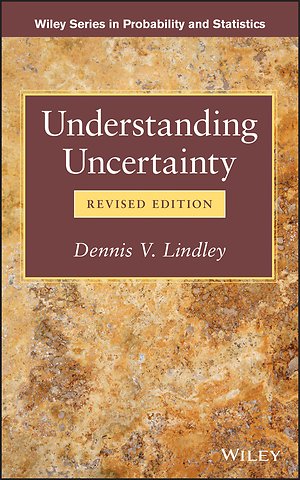

Understanding Uncertainty, Revised Edition
Gebonden Engels 2014 9781118650127Samenvatting
Praise for the First Edition
"...a reference for everyone who is interested in knowing and handling uncertainty."
Journal of Applied Statistics
The critically acclaimed First Edition of Understanding Uncertainty provided a study of uncertainty addressed to scholars in all fields, showing that uncertainty could be measured by probability, and that probability obeyed three basic rules that enabled uncertainty to be handled sensibly in everyday life. These ideas were extended to embrace the scientific method and to show how decisions, containing an uncertain element, could be rationally made.
Featuring new material, the Revised Edition remains the go–to guide for uncertainty and decision making, providing further applications at an accessible level including:
A critical study of transitivity, a basic concept in probability
A discussion of how the failure of the financial sector to use the proper approach to uncertainty may have contributed to the recent recession
A consideration of betting, showing that a bookmaker′s odds are not expressions of probability
Applications of the book s thesis to statistics
A demonstration that some techniques currently popular in statistics, like significance tests, may be unsound, even seriously misleading, because they violate the rules of probability
Understanding Uncertainty, Revised Edition is ideal for students studying probability or statistics and for anyone interested in one of the most fascinating and vibrant fields of study in contemporary science and mathematics.
Specificaties
Lezersrecensies
Inhoudsopgave
<p>Prologue xiii</p>
<p>1. Uncertainty 1</p>
<p>1.1. Introduction 1</p>
<p>1.2. Examples 2</p>
<p>1.3. Suppression of Uncertainty 7</p>
<p>1.4. The Removal of Uncertainty 8</p>
<p>1.5. The Uses of Uncertainty 9</p>
<p>1.6. The Calculus of Uncertainty 11</p>
<p>1.7. Beliefs 12</p>
<p>1.8. Decision Analysis 13</p>
<p>2. Stylistic Questions 15</p>
<p>2.1. Reason 15</p>
<p>2.2. Unreason 17</p>
<p>Literature 17</p>
<p>Advertising 17</p>
<p>Politics 18</p>
<p>Law 18</p>
<p>Television 18</p>
<p>2.3. Facts 19</p>
<p>2.4. Emotion 19</p>
<p>2.5. Prescriptive and Descriptive Approaches 20</p>
<p>2.6. Simplicity 22</p>
<p>2.7. Mathematics 23</p>
<p>2.8. Writing 25</p>
<p>2.9. Mathematics Tutorial 26</p>
<p>3. Probability 30</p>
<p>3.1. Measurement 30</p>
<p>3.2. Randomness 32</p>
<p>3.3. A Standard for Probability 34</p>
<p>3.4. Probability 35</p>
<p>3.5. Coherence 36</p>
<p>3.6. Belief 37</p>
<p>3.7. Complementary Event 39</p>
<p>3.8. Odds 40</p>
<p>3.9. Knowledge Base 43</p>
<p>3.10. Examples 44</p>
<p>3.11. Retrospect 46</p>
<p>4. Two Events 47</p>
<p>4.1. Two Events 47</p>
<p>4.2. Conditional Probability 49</p>
<p>4.3. Independence 51</p>
<p>4.4. Association 53</p>
<p>4.5. Examples 54</p>
<p>4.6. Supposition and Fact 56</p>
<p>4.7. Seeing and Doing 57</p>
<p>5. The Rules of Probability 59</p>
<p>5.1. Combinations of Events 59</p>
<p>5.2. Addition Rule 61</p>
<p>5.3. Multiplication Rule 62</p>
<p>5.4. The Basic Rules 64</p>
<p>5.5. Examples 66</p>
<p>5.6. Extension of the Conversation 68</p>
<p>5.7. Dutch Books 70</p>
<p>5.8. Scoring Rules 72</p>
<p>5.9. Logic Again 73</p>
<p>5.10. Decision Analysis 74</p>
<p>5.11. The Prisoners Dilemma 75</p>
<p>5.12. The Calculus and Reality 76</p>
<p>6. Bayes Rule 79</p>
<p>6.1. Transposed Conditionals 79</p>
<p>6.2. Learning 81</p>
<p>6.3. Bayes Rule 82</p>
<p>6.4. Medical Diagnosis 83</p>
<p>6.5. Odds Form of Bayes Rule 86</p>
<p>6.6. Forensic Evidence 88</p>
<p>6.7. Likelihood Ratio 89</p>
<p>6.8. Cromwell s Rule 90</p>
<p>6.9. A Tale of Two Urns 92</p>
<p>6.10. Ravens 94</p>
<p>6.11. Diagnosis and Related Matters 97</p>
<p>6.12. Information 98</p>
<p>7. Measuring Uncertainty 101</p>
<p>7.1. Classical Form 101</p>
<p>7.2. Frequency Data 103</p>
<p>7.3. Exchangeability 104</p>
<p>7.4. Bernoulli Series 106</p>
<p>7.5. De Finetti s Result 107</p>
<p>7.6. Large Numbers 109</p>
<p>7.7. Belief and Frequency 111</p>
<p>7.8. Chance 114</p>
<p>8. Three Events 117</p>
<p>8.1. The Rules of Probability 117</p>
<p>8.2. Simpson s Paradox 119</p>
<p>8.3. Source of the Paradox 121</p>
<p>8.4. Experimentation 122</p>
<p>8.5. Randomization 123</p>
<p>8.6. Exchangeability 125</p>
<p>8.7. Spurious Association 128</p>
<p>8.8. Independence 130</p>
<p>8.9. Conclusions 132</p>
<p>9. Variation 134</p>
<p>9.1. Variation and Uncertainty 134</p>
<p>9.2. Binomial Distribution 135</p>
<p>9.3. Expectation 137</p>
<p>9.4. Poisson Distribution 139</p>
<p>9.5. Spread 142</p>
<p>9.6. Variability as an Experimental Tool 144</p>
<p>9.7. Probability and Chance 145</p>
<p>9.8. Pictorial Representation 147</p>
<p>9.9. The Normal Distribution 150</p>
<p>9.10. Variation as a Natural Phenomenon 152</p>
<p>9.11. Ellsberg s Paradox 154</p>
10. Decision Analysis 158
<p>10.1. Beliefs and Actions 158</p>
<p>10.2. Comparison of Consequences 160</p>
<p>10.3. Medical Example 162</p>
<p>10.4. Maximization of Expected Utility 164</p>
<p>10.5. More on Utility 165</p>
<p>10.6. Some Complications 167</p>
<p>10.7. Reason and Emotion 168</p>
<p>10.8. Numeracy 170</p>
<p>10.9. Expected Utility 171</p>
<p>10.10. Decision Trees 172</p>
<p>10.11. The Art and Science of Decision Analysis 175</p>
<p>10.12. Further Complications 177</p>
<p>10.13. Combination of Features 179</p>
<p>10.14. Legal Applications 182</p>
<p>11. Science 186</p>
<p>11.1. Scientific Method 186</p>
<p>11.2. Science and Education 187</p>
<p>11.3. Data Uncertainty 188</p>
<p>11.4. Theories 190</p>
<p>11.5. Uncertainty of a Theory 193</p>
<p>11.6. The Bayesian Development 195</p>
<p>11.7. Modification of Theories 197</p>
<p>11.8. Models 199</p>
<p>11.9. Hypothesis Testing 202</p>
<p>11.10. Significance Tests 204</p>
<p>11.11. Repetition 206</p>
<p>11.12. Summary 208</p>
<p>12. Examples 211</p>
<p>12.1. Introduction 211</p>
<p>12.2. Cards 212</p>
<p>12.3. The Three Doors 213</p>
<p>12.4. The Newcomers to Your Street 215</p>
<p>12.5. The Two Envelopes 217</p>
<p>12.6. Y2K 220</p>
<p>12.7. UFOs 221</p>
<p>12.8. Conglomerability 224</p>
<p>13. Probability Assessment 226</p>
<p>13.1. Nonrepeatable Events 226</p>
<p>13.2. Two Events 227</p>
<p>13.3. Coherence 230</p>
<p>13.4. Probabilistic Reasoning 233</p>
<p>13.5. Trickle Down 234</p>
<p>13.6. Summary 236</p>
<p>Epilogue 238</p>
<p>Subject Index 243</p>
<p>Index of Examples 248</p>
<p>Index of Notations 250</p>
Rubrieken
- advisering
- algemeen management
- coaching en trainen
- communicatie en media
- economie
- financieel management
- inkoop en logistiek
- internet en social media
- it-management / ict
- juridisch
- leiderschap
- marketing
- mens en maatschappij
- non-profit
- ondernemen
- organisatiekunde
- personal finance
- personeelsmanagement
- persoonlijke effectiviteit
- projectmanagement
- psychologie
- reclame en verkoop
- strategisch management
- verandermanagement
- werk en loopbaan